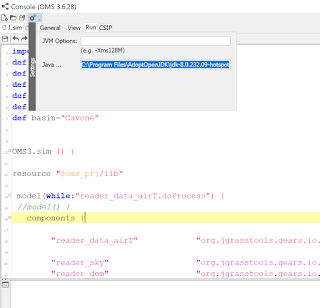2) Install it
3) Open a command prompt and run the command:
java -version
It should return:
openjdk version "1.8.0_232"
OpenJDK Runtime Environment (AdoptOpenJDK)(build 1.8.0_232-b09)
OpenJDK 64-Bit Server VM (AdoptOpenJDK)(build 25.232-b09, mixed mode)
OpenJDK Runtime Environment (AdoptOpenJDK)(build 1.8.0_232-b09)
OpenJDK 64-Bit Server VM (AdoptOpenJDK)(build 25.232-b09, mixed mode)
4) Download the Object Modeling System console version 3.6.28 from
5) Unzip the Object Modeling System console and run the console.bat file
6) In the console setting, select the panel Run and set the Java path (see screenshot) to the previously installed JDK which usually is:
C:\Program Files\AdoptOpenJDK\jdk-8.0.232.09-hotspot
(please check the correct JDK version first)











